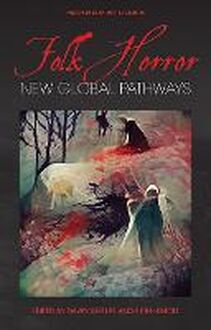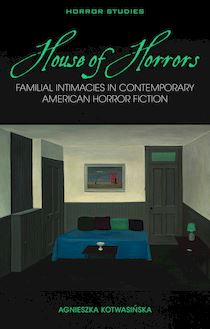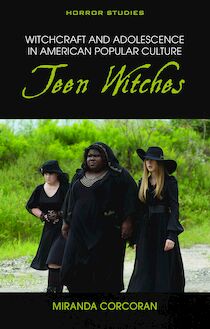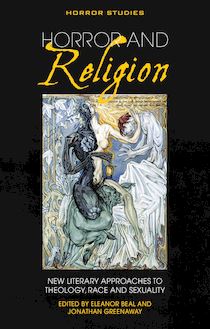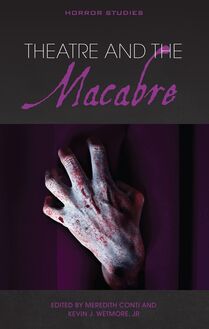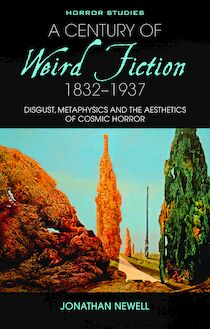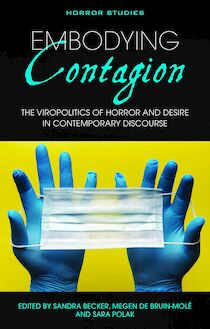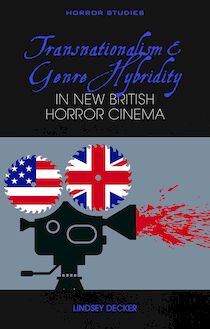The Blaxploitation Horror Film , livre ebook
147
pages
English
Ebooks
2023
Vous pourrez modifier la taille du texte de cet ouvrage
Obtenez un accès à la bibliothèque pour le consulter en ligne En savoir plus
Découvre YouScribe en t'inscrivant gratuitement
Découvre YouScribe en t'inscrivant gratuitement
147
pages
English
Ebooks
2023
Vous pourrez modifier la taille du texte de cet ouvrage
Obtenez un accès à la bibliothèque pour le consulter en ligne En savoir plus
Publié par
Date de parution
15 juin 2023
Nombre de lectures
0
EAN13
9781786839992
Langue
English
This book is a pioneering study of Blaxploitation horror films, connecting them with both mainstream horror movies and classic Gothic texts. The author argues that conventional horror films adapt, while Blaxploitation horror films appropriate, the archetypes of Gothic fiction – and rather than exploit, it is argued that they function to satisfy Black audiences. Of the few scholars who have given consideration to Blaxploitation horror films, only occasional chapters have been devoted by them in monographs focused on either Blaxploitation films or horror films. In marked contrast, the present study gives a book-length consideration to Blaxploitation horror films per se, demonstrating how they engage both Gothic fiction and film, and issues of vital significance to American society and culture in the 1970s. In this important and innovative study, chapters explore the sociocultural significance of the vampire, Frankenstein’s monster, Jekyll/Hyde and the werewolf, the zombie and the demon.
Acknowledgements
Introduction: Blaxploitation, Adaptation/Appropriation and the (Black) Gothic
1. Queer Bloodlines: The Vampire
2. Making Monsters: Frankenstein’s Creature
3. Beyond ‘the animal within’: Jekyll/Hyde and the Werewolf
4. Body and Soul: The Zombie and the Evil Spirit
Conclusion: The Legacy of the Blaxploitation Horror Film
Publié par
Date de parution
15 juin 2023
Nombre de lectures
0
EAN13
9781786839992
Langue
English
The Blaxploitation Horror Film
ADAPTATION, APPROPRIATION AND THE GOTHIC
HORROR STUDIES
Series Editor
Xavier Aldana Reyes, Manchester Metropolitan University
Editorial Board
Stacey Abbott, Roehampton University
Linnie Blake, Manchester Metropolitan University
Harry M. Benshoff, University of North Texas
Fred Botting, Kingston University
Steven Bruhm, Western University
Steffen Hantke, Sogang University
Joan Hawkins, Indiana University
Alexandra Heller-Nicholas, Deakin University
Agnieszka Soltysik Monnet, University of Lausanne
Bernice M. Murphy, Trinity College Dublin
Johnny Walker, Northumbria University
Maisha Wester, Indiana University Bloomington
Preface
Horror Studies is the first book series exclusively dedicated to the study of the genre in its various manifestations – from fiction to cinema and television, magazines to comics, and extending to other forms of narrative texts such as video games and music. Horror Studies aims to raise the profile of Horror and to further its academic institutionalisation by providing a publishing home for cutting-edge research. As an exciting new venture within the established Cultural Studies and Literary Criticism programme, Horror Studies will expand the field in innovative and student-friendly ways.
The Blaxploitation Horror Film
ADAPTATION, APPROPRIATION AND THE GOTHIC
JAMIL MUSTAFA
For Dennis
© Jamil Mustafa, 2023
All rights reserved. No part of this book may be reproduced in any material form (including photocopying or storing it in any medium by electronic means and whether or not transiently or incidentally to some other use of this publication) without the written permission of the copyright owner except in accordance with the provisions of the Copyright, Designs and Patents Act. Applications for the copyright owner’s written permission to reproduce any part of this publication should be addressed to the University of Wales Press, University Registry, King Edward VII Avenue, Cardiff, CF10 3NS.
www.uwp.co.uk
British Library Cataloguing-in-Publication Data
A catalogue record for this book is available from the British Library.
ISBN 978-1-78683-997-8
eISBN 978-1-78683-999-2
The right of Jamil Mustafa to be identified as author of this work has been asserted in accordance with sections 77 and 79 of the Copyright, Designs and Patents Act 1988.
The publisher has no responsibility for the persistence or accuracy of URLs for any external or third-party internet websites referred to in this book, and does not guarantee that any content on such websites is, or will remain, accurate or appropriate.
Cover image: Scream Blacula Scream (1973).
Everett Collection Inc / Alamy Stock Photo.
Contents
Acknowledgements
List of illustrations
Introduction
Blaxploitation, Adaptation/Appropriation and the (Black) Gothic
1. Queer Bloodlines
The Vampire
2. Making Monsters
Frankenstein’s Creature
3. Beyond ‘the animal within’
Jekyll/Hyde and the Werewolf
4. Body and Soul
The Zombie and the Evil Spirit
Conclusion
The Legacy of the Blaxploitation Horror Film
Notes
Bibliography
Filmography
Acknowledgements
I AM GRATEFUL TO Sarah Lewis, Head of Commissioning at the University of Wales Press, for moving this book forward and for keeping it (and me) on track. I would also like to thank Xavier Aldana Reyes for the advice that he offered when we initially discussed this project. Finishing it in three years would not have been possible without the support of those at Lewis University who awarded me a very timely and valuable sabbatical. I am also deeply indebted to the readers whose constructive commentary on the first draft of the manuscript greatly improved the final version. Finally, my heartfelt thanks are due to colleagues, friends and family members who were brave enough to ask, ‘What’s the book about?’, and patient enough to listen to my answer. Writing can be an isolated and isolating experience, but their interest and encouragement kept me connected.
List of Illustrations
Figure 1. Blacula (William Marshall) attacks Billy Schaffer (Rick Metzler) in Blacula (1972). AIP/Photofest
Figure 2. Blacula (William Marshall) attacks Willis Daniels (Richard Lawson) in S cream Blacula Scream (1973). AIP/Photofest
Figure 3. Jack Moss (Rosey Grier) is conjoined with Dr Maxwell Kirshner (Ray Milland) in The Thing with Two Heads (1972). AIP/Photofest
Figure 4. Eddie Turner (Joe DeSue) degenerates into a monster in Blackenstein (1972). Exclusive International/Photofest
Figure 5. Dr Henry Pride (Bernie Casey) transforms into his alter ego in Dr. Black, Mr. Hyde (1976). Dimension Pictures/Photofest
Figure 6. Tom Newcliffe (Calvin Lockhart) targets the werewolf in The Beast Must Die (1974). Cinerama Releasing Corporation/Photofest
Figure 7. Bishop Garnet Williams (William Marshall) employs syncretic clothing and objects in Abby (1974). AIP/Photofest
Figure 8. Memphis (Wally Taylor) and Jenny (Marlene Clark) watch Billie (Avis McCarther) in Lord Shango (1975). Bryanston Pictures/Photofest
Figure 9. Petey (Rudy Ray Moore) holds the Devil’s cane in Petey Wheatstraw (1977). Generation International Pictures/Photofest
Introduction
Blaxploitation, Adaptation/Appropriation and the (Black) Gothic
W ITH THE RELEASE of films including Cotton Comes to Harlem (Ossie Davis, 1970), Sweet Sweetback’s Baadasssss Song (Melvin Van Peebles, 1971), Shaft (Gordon Parks, 1971) and Super Fly (Gordon Parks Jr, 1972), a genre emerged that came to be known as ‘Blaxploitation’. 1 This pejorative portmanteau word for what Novotny Lawrence characterises as ‘the flood of black-oriented films depicting sex, violence, vigilantes, pimps, and drug dealers’ 2 racialised ‘exploitation’ cinema, an industry term used since the 1950s to describe films that had ‘low, substandard budgets’, capitalised on ‘topical issues and controversial trends, thus enabling sensational promotion’, and ‘included explicit and stimulating subject matter’. 3 ‘Blaxploitation’ was coined by Junius Griffin, once the president of the Beverly Hills-Hollywood branch of the National Association for the Advancement of Colored People (NAACP). 4 Throughout the 1970s, Griffin and others working for civil rights protested against what they viewed as the white film industry’s distortion of Black lives, and its exploitation of the intense desire of African American audience members to see themselves represented on screen. As Jesse Algeron Rhines explains, ‘These films were released during the height of the civil rights/Black liberation movement, yet their subject matter of sex, violence and “super-cool” individualism was the antithesis of what contemporaneous [B]lack political organisations … supported for Black people’. 5 These groups advocated for racial self-determination, empowerment, pride and solidarity – values that, while hardly absent from Blaxploitation films, were generally obscured by their luridness. In 1972, the NAACP, the Southern Christian Leadership Conference and the Urban League formed the Coalition Against Blaxploitation, which sought to establish a ratings system for Black films ranging from ‘superior’ to ‘thoroughly objectionable’. 6 This proposal ‘sparked a public debate that included a host of actors, producers, directors, writers, and intellectuals’, some of whom argued that audiences were the best judges of content, and that Blaxploitation films not only provided the representation that viewers craved, but also created opportunities for African Americans within the film industry. 7
A neutral characterisation of Blaxploitation would note that the genre’s protagonists are strong African American men, and sometimes women, who live and work within Black urban spaces such as Harlem in New York City and Watts in Los Angeles, and who fight against the injustices of white hegemony on (n)either side of the law. John Shaft of Shaft is a detective, as are ‘Gravedigger’ Jones and ‘Coffin Ed’ Johnson in Cotton Comes to Harlem . Youngblood Priest of Super Fly is a drug dealer. Sweet Sweetback, the eponymous protagonist of Sweet Sweetback’s Baadasssss Song , is a sex worker turned rebel. All these diverse figures ‘are strong because they possess the ability to survive in and navigate the [white] establishment while maintaining their blackness’, Lawrence writes. They ‘may work for or within the system; however, they do so on their own terms and for the betterment of the black community’. 8 These empowered and empowering characters featured in a wide range of narratives, since ‘Blaxploitation incorporated elements of many other genres’ and included comedies, westerns, melodramas, contemporary dramas and horror films. 9
The appeal that Blaxploitation held for African American filmgoers was crucial to the business of cinema. ‘By the late 1960s, Hollywood, in the midst of a financial collapse, was desperate for an influx of cash’, Paula J. Massood explains. ‘It began to target an African American audience, in part because it was estimated that the black box office generated somewhere between 30 and 40 percent of the total American box office.’ 10 Indeed, according to Donald Bogle, ‘the black audience’s support of the new black films may well have saved the commercial film industry at a time when general ticket sales were in a slump’. 11 Bogle goes on to claim that Blaxploitation is important in cinematic history not only because it was so lucrative, but also because ‘the success of the black-oriented films helped change the look and feel of the American feature’, influencing works including Martin Scorsese’s Mean Streets (1973) and Taxi Driver (1976), together with Sidney Lumet’s Dog Day Afternoon (1975) and John G. Avildsen’s Rocky (1976). 12
Although these profitable and culturally significant films featured Black performers and were marketed to and viewed by Black audiences, the extent to which they represented the creative vision of African Americans is debatable. All four of
